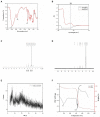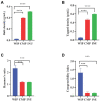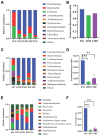Characteristics and properties of a polysaccharide isolated from Wolfiporia cocos as potential dietary supplement for IBS
- PMID: 37051119
- PMCID: PMC10083290
- DOI: 10.3389/fnut.2023.1119583
Characteristics and properties of a polysaccharide isolated from Wolfiporia cocos as potential dietary supplement for IBS
Abstract
Introduction: As low FODMAP (Fermentable oligosaccharides, disaccharides, monosaccharides and polyols) diet therapy is recommended for most of Irritable Bowel Syndrome (IBS) patients, the consequent insufficient of dietary fibers (DFs) intake exert an adverse impact on intestinal health. It is necessary to find suitable DFs for IBS patients.
Methods: This study extracted a water-insoluble polysaccharide from Wolfiporia cocos (WIP) by alkali-extraction and acid-precipitation method. Its molecular weight was detected by high performance gel permeation chromatography (HPGPC) analysis. The structure of WIP was analyzed by Fourier transform infrared (FT-IR) spectrum, Nuclear Magnetic Resonance (NMR) spectra and X-ray diffraction (XRD). The properties related to stability, digestion, viscosity, osmotic activity, adsorption and fermentation were investigated, aimed to explore the feasibility of WIP as a new DF supplement for patients with IBS. In addition, 16S rRNA sequencing analysis was conducted to explore its effects on IBS-related gut microbiota.
Results and discussion: The results showed that WIP had a single homogeneous composition and the molecular weight was 8.1 × 103 Da. WIP was indicated as a kind of pyranose form with β anomeric configuration and the main chain of WIP was 1,3-β-glucan with amorphous structure. In addition to good thermal stability, WIP also has low bioavailability and can reach the colon mostly without being digested. Moreover, the low viscosity and osmotic activity, the high water- swelling and water/oil-holding capacity, fructose adsorption capacity and poor fermentation performance of WIP demonstrated that it is suitable for IBS patients. It is worth noting that WIP regulates IBS associated gut microbiota effectively, such as the abundance of Lachnospiraceae and Prevotella. These findings provide a theoretical basis for the development of WIP as a dietary supplement for IBS patients with low FODMAP diet therapy. GRAPHICAL ABSTRACT.
Keywords: Wolfiporia cocos; diet therapy; gut microbiota; in vitro digestion; in vitro fermentation; irritable bowel syndrome; polysaccharide.
Copyright © 2023 Yang, Lu, Feng, Cao, Zhang and Cheng.
Conflict of interest statement
The authors declare that the research was conducted in the absence of any commercial or financial relationships that could be construed as a potential conflict of interest.
Figures













Similar articles
-
An insoluble polysaccharide from the sclerotium of Poria cocos improves hyperglycemia, hyperlipidemia and hepatic steatosis in ob/ob mice via modulation of gut microbiota.Chin J Nat Med. 2019 Jan;17(1):3-14. doi: 10.1016/S1875-5364(19)30003-2. Chin J Nat Med. 2019. PMID: 30704621
-
Does Fibre-fix provided to people with irritable bowel syndrome who are consuming a low FODMAP diet improve their gut health, gut microbiome, sleep and mental health? A double-blinded, randomised controlled trial.BMJ Open Gastroenterol. 2020 Aug;7(1):e000448. doi: 10.1136/bmjgast-2020-000448. BMJ Open Gastroenterol. 2020. PMID: 32816830 Free PMC article. Clinical Trial.
-
Low fermentable oligosaccharides, disaccharides, monosaccharides and polyols (FODMAP) diet improves symptoms in adults suffering from irritable bowel syndrome (IBS) compared to standard IBS diet: A meta-analysis of clinical studies.PLoS One. 2017 Aug 14;12(8):e0182942. doi: 10.1371/journal.pone.0182942. eCollection 2017. PLoS One. 2017. PMID: 28806407 Free PMC article.
-
Low fermentable oligosaccharides, disaccharides, monosaccharides, and polyols diet in children.World J Clin Cases. 2019 Sep 26;7(18):2666-2674. doi: 10.12998/wjcc.v7.i18.2666. World J Clin Cases. 2019. PMID: 31616683 Free PMC article. Review.
-
Diet, fibers, and probiotics for irritable bowel syndrome.J Med Life. 2022 Feb;15(2):174-179. doi: 10.25122/jml-2022-0028. J Med Life. 2022. PMID: 35419092 Free PMC article. Review.
Cited by
-
From Genes to Healing: The Protective Mechanisms of Poria cocos Polysaccharide in Endometrial Health.Curr Issues Mol Biol. 2025 Feb 21;47(3):139. doi: 10.3390/cimb47030139. Curr Issues Mol Biol. 2025. PMID: 40136393 Free PMC article.
-
The Role of Wolfiporia cocos (F. A. Wolf) Ryvarden and Gilb. Polysaccharides in Regulating the Gut Microbiota and Its Health Benefits.Molecules. 2025 Mar 7;30(6):1193. doi: 10.3390/molecules30061193. Molecules. 2025. PMID: 40141970 Free PMC article. Review.
-
A Systematic Review on the Research Progress on Polysaccharides from Fungal Traditional Chinese Medicine.Molecules. 2023 Sep 27;28(19):6816. doi: 10.3390/molecules28196816. Molecules. 2023. PMID: 37836659 Free PMC article.
-
In Vitro Fermentation Characteristics of Fungal Polysaccharides Derived from Wolfiporia cocos and Their Effect on Human Fecal Microbiota.Foods. 2023 Nov 2;12(21):4014. doi: 10.3390/foods12214014. Foods. 2023. PMID: 37959133 Free PMC article.
-
The potential of Sijunzi decoction in the fight against gastrointestinal disorders: a review.Front Pharmacol. 2025 Mar 4;16:1464498. doi: 10.3389/fphar.2025.1464498. eCollection 2025. Front Pharmacol. 2025. PMID: 40103588 Free PMC article. Review.
References
-
- Zhang DD, Li HJ, Zhang HR, Ye XC. Poria Cocos water-soluble polysaccharide modulates anxiety-like behavior induced by sleep deprivation by regulating the gut dysbiosis, metabolic disorders and TNF-alpha/NF-kappa B signaling pathway. Food Funct. (2022) 13:6648–64. doi: 10.1039/d2fo00811d, PMID: - DOI - PubMed
-
- Lu J, Li C, Liu L, Chai W, Hou Y, Ma C. Rapid determination of pachymic acid content by near-infrared spectroscopy. J Food Qual. (2022) 2022:1–7. doi: 10.1155/2022/9746414 - DOI
-
- Hua H, Yi Y, Li H, Chen C. Monitoring the extraction process of acidic polysaccharides in Poria Cocos by near infrared spectroscopy combined with chemometrics. Infr Phys Technol. (2021):103613: 113. doi: 10.1016/j.infrared.2020.103613 - DOI
LinkOut - more resources
Full Text Sources
Research Materials
Miscellaneous

